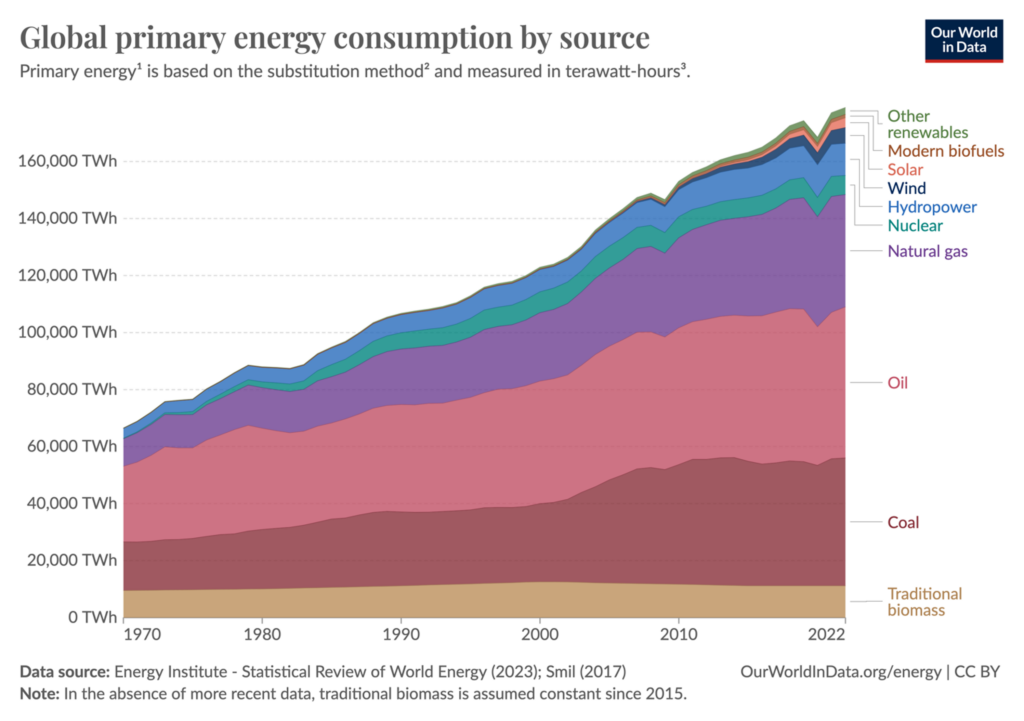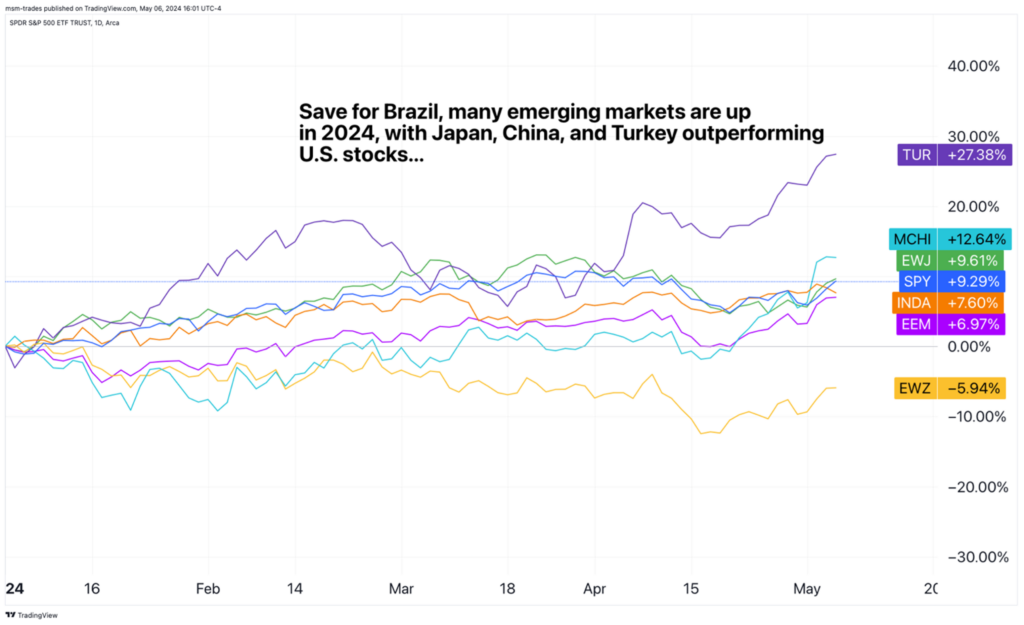Buffett Is Bearish
|
Listen to this post
|
Warren Buffett is implicitly bearish on U.S. stocks… Why we can’t ignore the AAPL sale… The legacy energy business is not going anywhere soon… One area abroad that Buffett finds interesting… Jonathan Rose’s legendary 7-trade streak and how he pulled it off, revealed…
By Michael Salvatore, Editor, TradeSmith Daily
Last weekend was my first time watching the Berkshire Hathaway Annual Shareholder Meeting. (Though over the years, I’ve caught plenty of clips of Charlie Munger being the witty scoundrel he was – may he rest in peace.)
Berkshire’s meeting is probably the most celebrated event in the financial world. Thousands of investors make the trek to Omaha, Nebraska, to watch its Oracle reflect on the firm’s previous year and look forward to the future – not to mention all the folks watching at home.
Scores of investors line up outside the convention center in the wee hours of the morning, just for the chance to ask Warren Buffett a question.
From both Berkshire’s reporting and the Q&A, I came away with four significant insights. Two shot to the top of the mainstream media headlines, and two didn’t:
- Berkshire’s cash position is at an all-time high, showing an implicit bearishness on risk assets.
- Berkshire reduced its Apple stake by 13% and suggested it’s for tax reasons.
- Buffett thinks the renewable energy trade is still too early, and that solar will never be the only power source.
- And he signaled the world’s fastest-growing large foreign economy could be a target for his successor.
Let’s take a minute today to unpack each…
1. A cash position of $189 billion – which Buffett said could grow past $200 billion – shows the competition between Treasurys and risk assets is still in full force.
It’s hard to justify putting money to work in risk assets when there’s so much to be gained from the alternative – doing almost nothing. Especially when short-term Treasurys are yielding 5.4%. Their return on such a large cash hoard amounts to a risk-free $10.2 billion a year.
If Warren Buffett doesn’t think he can do better than 5.4% in the stock market, even as stocks have run almost 9% higher so far this year, that’s worth paying attention to.
Indeed, the famous “Buffett Indicator” – a measure of U.S. stock market value divided by GDP – crossed into “strongly overvalued” back in March, as you see below. GDP has slowed since the last reading, along with stock gains, so it likely now sits just below it.

Following the Buffett Indicator has strong merit because it would’ve had you grabbing stocks in the early ’50s, the late ’70s, and 2009. Talk about “buy the dip” – those were all incredible times to put cash to work.
Does this mean there’s no way to make money buying stocks now? Absolutely not. An expensive market can always get more expensive and leave value-anxious investors behind.
But the truly massive long-term returns are made from buying when the crowd hates stocks. That’s when the line above goes below 0… and that’s not right now.
2. Trimming AAPL by such a large extent speaks volumes in a similar way.
AAPL is the No. 2 company in the S&P 500, making up more than 6% of America’s retirement account. It’s been a bit “sideways” of late, given difficulties on multiple fronts like abandoning the car project, slowing sales in China, and falling behind on AI.
TradeSmith’s own trend indicator, the Smart Moving Average (dotted line below), shows that AAPL is in a side-trend and therefore not a great buy, with shares about flat over the last year.
While AAPL did just pop back into our Health Indicator Green Zone, shares have also gotten a little overbought on the Relative Strength Index (RSI), which you’ll find under the price chart.

Berkshire’s stated reason for selling AAPL – anticipating higher taxes – means two things. One, they probably expect Democrats to win in November. And two… even though this isn’t what they want to say… they’re a little bearish on AAPL.
Tim Cook was in the audience, so it was hard for Berkshire to be totally forthcoming with this stance, but it makes sense. Regardless of high taxes or low taxes, you don’t sell a stock you want to own for the long haul.
Berkshire clearly doesn’t want to own as much AAPL as they did before for at least the next year. Whatever the reason, and even if it truly is just to take some capital gains at a perceived lower tax rate, that is noteworthy.
3. Buffett is interested in renewable energy but thinks it will take time, and that solar will never be the sole energy source.
This will sound familiar to regular TradeSmith Daily readers. We’ve been pounding the table on oil & gas stocks for the past six months, along with higher-capacity alternative energy ideas like nuclear , for exactly this reason.
For how much investment has gone into renewable energy, it hasn’t managed to take much market share from the legacy energy business.
Just look at this chart we first shared months ago, which shows how the share of global energy production has stayed predominantly in oil (pink shading), natural gas (purple shading), and even coal (red shading) for the last 50 years.

If anything, the presence of fossil fuels has grown in the last 20 years while the share of renewables has taken only a tiny sliver of the pie.
The takeaway is clear. Continue to own cash-rich and shareholder-friendly legacy energy businesses (and while you’re at it, trade options on them for income). The transition away from them will more likely be an investing challenge my children will contend with.
4. Warren Buffett isn’t interested in most foreign markets, but he thinks his successors could do well in India.
Berkshire’s portfolio is overwhelmingly in U.S. stocks, exhibiting the kind of “home country bias” we’ve talked about before.
But in 2020,Buffett invested about $6 billion in five Japanese trading houses and holds some exposure in foreign companies like Aon, Nu Holdings, and Liberty Latin America.
Granted, this exposure is very small: less than 1% of the portfolio combined. He also added that it’s “unlikely we will make any large commitments in other countries.” But one moment did get an eyebrow raise out of me.
One Rajeev Agrawal of U.S.-based hedge fund DoorDarshi Advisors asked Buffett if he would consider investing in India – the fifth-largest economy and far and away the fastest-growing major economy in the world.
Buffett responded saying he’s confident there are plenty of opportunities in India, but that it would be something a “more energetic” management could pursue in the future.
The meeting was laden with talk about Buffett’s succession, clearly indicating for the first time that Berkshire’s vice chairman, Greg Abel, would take over Buffett’s duties once he passes. It’s worth wondering if, once this happens, Berkshire Hathaway would be more willing to put capital to work in higher-risk, higher-growth markets.
It’s also, naturally, an endorsement of India as an area of investment and emerging markets more broadly.
For context, here’s a glance at some of the larger emerging market country performances against U.S. large-caps. Top to bottom, we’ve got Turkey (TUR), China (MCHI), Japan (EWJ), the S&P 500 ETF (SPY), and India (INDA) all coming in above an emerging-markets basket (EEM). Then Brazil (EWZ) is lagging behind with the only year-to-date decline.

Thus far in 2024, that emerging-markets basket is not outperforming the S&P 500 as we suggested it might at the start of the year. But watch this space… because as you can see, some outliers are already outpacing the U.S. market.
We’ve talked a lot about a legendary investor in today’s Daily…
So now I’d like to turn our attention to a legendary hot streak from an incredible short-term trader.
Over the last month and a half, CBOE pit-trading veteran Jonathan Rose shared seven opportunities that, on average, would’ve more than doubled your money in a matter of weeks… if not days.
I’ll go out on a limb and say few traders can claim seven separate 125% wins in the span of two months. (If you know of one, email us at [email protected], because we’d love to know them, too.)
He shared these opportunities 100% for free, by the way, to folks who signed up to view his daily livestreamed trading sessions. In these free lessons, he’s been showing his followers all along how gains like this are possible.
It’s not from having insider information… or complicated hedging… or trading tiny micro-cap stocks that make huge moves in a single day – but are just as prone to going sharply against you.
It comes down to one single factor that Jonathan owes much of his success to. And with just a little know-how and practice, any investor can apply it to their own strategy.
In less than two hours, Jonathan is going live at the Masters in Trading Summit with co-host John Burke to reveal this special factor and share his plan for empowering as many traders as possible with it.
If you haven’t already signed up and received the free three-part training sessions to prepare for today’s webinar, don’t delay another moment.
Because if what’s to come is anything like what Jonathan has already proven he can do, 2024 could be a banner year for those bold enough to break from the crowd and learn to harness market volatility.
To your health and wealth,
Michael Salvatore
Editor, TradeSmith Daily